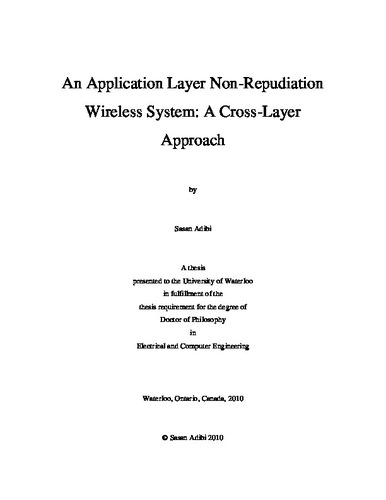| dc.description.abstract | Non-repudiation techniques are to ensure any communication taking place between two or more parties will be undeniable. Therefore it is crucial to include digital signatures of the involving parties while the communication is taking place. In medical practices, involved parties include; patient(s), doctor(s), pharmacist(s), who are involved in series of visits, diagnosis, prescriptions, and possible operations. To avoid possible conflicts, deploying non-repudiation techniques help immensely. This thesis considers this issue in a wireless medium and studies the Quality of Service (QoS)/Security requirements in terms of network parameters and performance metrics.
In terms of research contributions, this thesis embodies a thorough research on layered and cross-layer QoS and security schemes, in particular, featuring an adaptive Forward Error Correction (FEC) at the application layer, adapting to channel conditions. This leads to a cross layer design, which considers various QoS and security parameters export and import to and from various layers with a special focus on the application layer.
The aim of this thesis is to consider a practical implementation and associated complexities of a non-repudiation system, including analytical and experimental testbeds and results. The security schemes are based on Suite-B cryptographic algorithms, including: The Elliptic Curve Diffie-Hellman (ECDH) for key agreement, the Advanced Encryption Standard - Galois/Counter Mode (AES-GCM) for encryption and authentication, the Elliptic Curve Digital Signature Algorithm (ECDSA) for digital signatures, and the Secure Hash Algorithm (SHA) for integrity. A key aspect of Suite-B is the deployment of Elliptic Curve Cryptography (ECC).
The non-repudiation aspect of this thesis is based on the Suite-B’s digital signature scheme; ECDSA. The digital signature and the hashing function target the entire multimedia data (i.e., text, video, and voice) and the challenge is to offer such extensive security treatment, while guaranteeing certain Quality of Service settings. These settings include: minimum round trip delay, maximum overhead, and minimum bandwidth allocation. | en |

